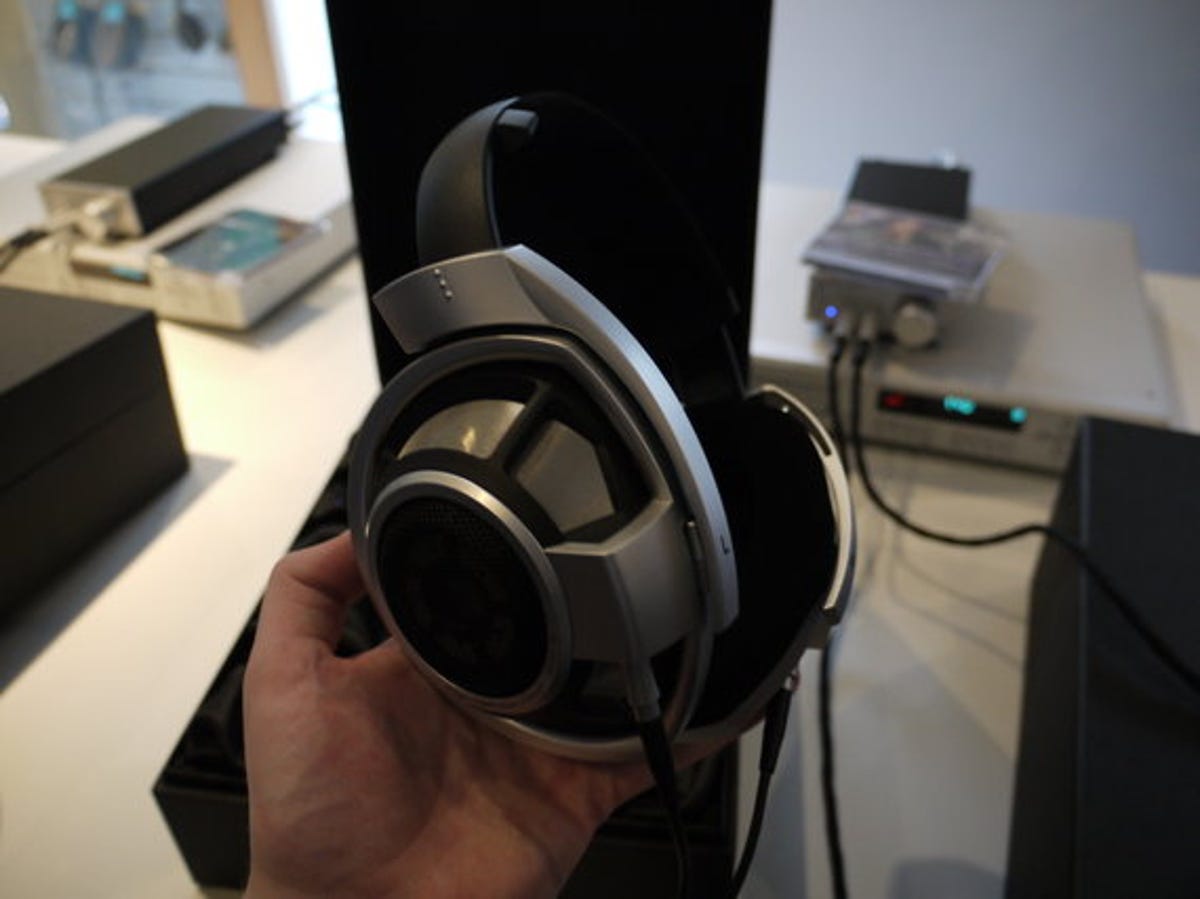
Crave flew all the way to Germany this week to hear what was promised to be the best headphone in the world -- the greatest, most paradigm-shifting personal audio equipment man has ever seen. With his ears. After an afternoon of listening tests at Sennheiser HQ with Professor Sennheiser himself, even Sceptical Cat (she travels everywhere with us) admitted she was close to believing the company's claim. They're the successor to the superb HD 650s, Sennheiser's new flagship headphone -- Damen und Herren, the £1,000 HD 800s!
Our first glimpse of the HD 800s was at CES back in January. They use an entirely new type of doughnut-shaped diaphragm for bouncing sound towards you, and at a slight angle to mimic the way sound enters the ear from floor-standing speakers -- an idea dating back, CEO Jörg Sennheiser told us himself today, to 1994. The HD 800s didn't begin development until 2002, but have been painstakingly perfected ever since, until their launch this year.
Listening test
We had the HD 800s amped through a T+A SACD player and a Lehmannaudio headphone amplifier, listening to a range of songs from Dire Straits, Diana Krall and even a little Destiny's Child. The resolution and definition from these headphones is exemplary -- moist-making and grin-producing, putting our beloved and highly rated £800 Denon AH-D7000s in a sore second place on the we-would-genuinely-consider-intercourse-with-these-headphones scale.
Their sonic transparency, openness and detailed voice was incredible, working us up more than the Denons, more than the classic Grados, more than Audio Technica's W5000s. And that, truly, is saying something.
Fo' shizzle, we didn't have our usual meat feast of recordings to test with, so we're saving a small side-salad of opinion for the tests that come from our own listening room, with our own equipment. But their sheer brilliance and clarity was mesmerising -- although we suspect as a result of this, fans of modern rock and electronic music won't want to crank these up to the maximum, unless bleeding from the ears is some sort of masochistic pastime, you sick puppy. What's the matter with you?
That aside, experiencing these headphones is akin to having your head oiled and massaged by Mother Nature herself.
What's on the inside?
The 56mm ring-shaped diaphragm, which we discussed in detail in our previous report and show in the photo below, is coupled to one of the largest neodymium magnets in any dynamic headphone, along with an aluminium voice coil containing three and a half layers of aluminium wiring. Together they offer a frequency response of 6Hz-51kHz, a rated impedance of 300 Ohms and a low total harmonic distortion of less than 0.02 per cent at 1kHz/100dB, along with Teflon-insulated oxygen-free cabling.
They're comfortable as well, and less tight around the skull than the HD 650s. One point to note is how wearing the headphones didn't affect the ambient sound around us. They're so open there's barely an audible clue that you're wearing anything around your ear, and this helped create an even more open sound than the HD 650s, at least on par with Grado's offering in terms of openness, if not a step greater.
For sure, these are costly. They're mind-bogglingly expensive even to devotees of high-end headphones, and we think a two-year warranty is pathetic. And there's no need to go to this level of expense to experience breathtakingly high-quality audio -- Denon's AH D5000 or D7000, AKG's K 701 or Sennheiser's own HD 650 all cost around half as much and offer stunning sound by almost everyone's standards.
The final word, for now
If you want the most inspiring, mouth-wateringly gorgeous and stunning personal audio on the planet, these are the headphones you want to try out. Considering a home hi-fi can easily cost upwards of £10,000, or even £100,000, this is a comparatively affordable entry into bleeding-edge music listening. Just remember: you need an amp, or a headphone amp (such as a smashing Woo Audio, which we'll be testing them with) to drive them -- simply plugging in your iPod won't do, and in fact wouldn't fit the 6.3mm plug anyway.
They'll be on sale later this year, and we'll have our full review when they come in-house. Until then, enjoy our hands-on pictures over the next few pages, and keep your eye on Crave next week for a tour behind the scenes of Sennheiser's manufacturing facility, where we'll show you how the HD 800s are put together, from start to finish.